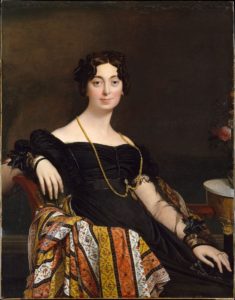In the first half of the 19th century, struggling young artists such as Jean-Auguste-Dominique Ingres (1780-1867) made a decent living from portrait painting while trying to build a reputation with more ambitious pictures of historical and mythological subjects.
History played a trick on Ingres, however; today the portraiture that he considered his day job is considered by some to be his best work.
“Portraits by Ingres: Image of an Epoch,” which opened this week at the Metropolitan Museum, makes a strong case for this, while, as the title suggests, giving us a sociological who’s who of the ruling elite of his time.

Ingres was a classicist. He strove to give his figures the perfection and balance of Greek statues. This was easier in the history paintings than in the portraits. But the tension between the competing demands of likeness and classical ideal is part of the appeal of these paintings.
In the art history books, Ingres is often juxtaposed with his hated rival, Eugene Delacroix. The two were opposites in every way: Delacroix was as passionate and romantic as Ingres was cool and controlled. When Delacroix painted the violin virtuoso Niccolo Paganini he used such expressionistic brush strokes that the musician’s body seems to undulate with the music.
None of that for Ingres. An accomplished violinist himself, he considered Paganini a vulgar showoff. His pencil portrait depicts the musician with his violin under his arm, gazing out calmly at us – a case of the artist endowing his subject with his own temperament. But it’s the quality of the drawing that sways us, the clean, elegant lines that delineate the form.
Generations of artists have swooned over Ingres’ lines, including such great draftsmen as Degas and Picasso. The paintings hide their secrets beneath smooth, glossy surfaces, whereas the drawings show us how it was done, the essential structure and underlying geometry.
There’s an eccentricity in Ingres’ idea of classical perfection. He liked to give women swan-like necks and sometimes impossibly long arms and fingers, as in one of his most beautiful portraits, that of Princesse Albert de Broglie. In another, of Vicomtesse Othenin d’Haussonville, we sense the presence of a perfectly round ball within her head. He preferred curvaceous spines, to the point where there is often something boneless about his subjects.
In the matter of wrinkles, Ingres was at one with the feminine ideal: as few as possible. His subjects’ faces are as smooth and uniform as the surface of an egg. His portrait of the frank, wide-eyed Comtesse de Tournon, who was about 60 at the time he painted her, employs various devices to hide the signs of age. The wrinkles on her forehead are hidden by a fringe of curls, and her neck is concealed behind an elaborate lace ruff.
Ingres was not one of those artists who, like Rembrandt, tried to peer into the souls of his subjects. He is quite satisfied with the surface reality and excelled at conveying tactile impressions. In the portrait of Princesse Broglie, he throws himself enthusiastically into the rendering of a lace and glistening satin dress, a gold damask chair, a silk scarf laying over it, a pair of limp white gloves, and a leather cape.
As a student of personality, Ingres often looks no further than the sitter’s own opinion of himself, and, given the outsized egos he worked with, the show has a thick atmosphere of self-importance. But other qualities shine through, as in the famous portrait of Louis-Francois Bertin, on loan from the Louvre. Bertin was one of the most powerful newspapermen of his age. His impressive bulk and penetrating eyes are reinforced by a latent energy, evident in the way the hands are planted firmly on each thigh. Ingres is said to have agonized in the process of finding this pose, even, the story goes, breaking down in tears during one sitting.
Equally telling is his pencil drawing of the young pianist and composer Franz Liszt. Liszt was at a point in his young life where he was disillusioned with the state of culture in his time, and was also at the end of a scandalous three-year affair that had produced three children. With its limpid eyes, the drawing conveys a wistful and romantic melancholy.
Here, and elsewhere, Ingres achieves that sense of calm and stillness, the feeling of time stopping, that little hint of eternity, that is at the core of classicism.
Metropolitan Museum of Art
1999

